
Agapeta zoegana is a species of moth known as the sulphur knapweed moth and the yellow-winged knapweed root moth. It is used as an agent of biological pest control against noxious knapweeds, particularly spotted knapweed and diffuse knapweed.

Acleris forsskaleana, the maple leaftier moth, is a moth of the family Tortricidae. It is found in Europe and North America in woodlands and gardens.

Archips xylosteana, the variegated golden tortrix or brown oak tortrix, is a moth of the family Tortricidae.
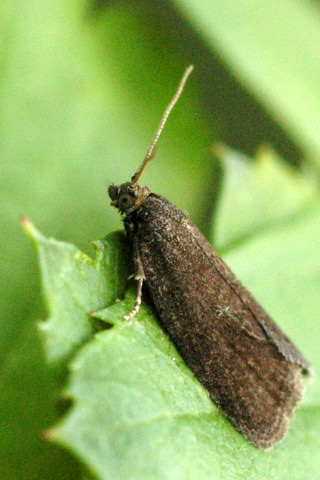
Aphelia viburnana, the bilberry tortrix, is a moth of the family Tortricidae. It is found in Europe, from Portugal and Great Britain to the Ural Mountains, Siberia and Mongolia, further east to the Russian Far East.

Aleimma loeflingiana is a moth of the family Tortricidae. It is found in Europe and the Near East.

Celypha cespitana is a moth of the family Tortricidae. It is found in the Palearctic realm, from western Europe to the Ural Mountains, Transcaucasia, Asia Minor, the Near East, Iran, Russia, north-eastern China (Manchuria), Korea and Japan. It is also found in the Nearctic realm.
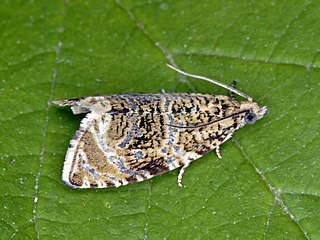
Syricoris lacunana, the dark strawberry tortrix, is a small moth species of the family Tortricidae. It is found in the Palearctic realm.

Celypha rufana, common name lakes marble, is a small moth species of the family Tortricidae, long known under the junior synonym C. rosaceana.

Archips rosana, the rose tortrix, is a moth of the family Tortricidae. It is found in both the Palearctic and Nearctic realms.
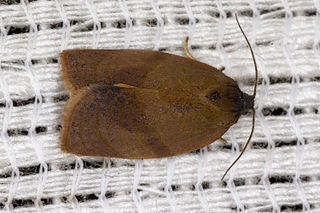
Cacoecimorpha is a monotypic moth genus of the family Tortricidae. Cacoecimorpha pronubana—the carnation tortrix—is its sole species and is found in Europe, northern Africa, South Africa, Anatolia and North America.
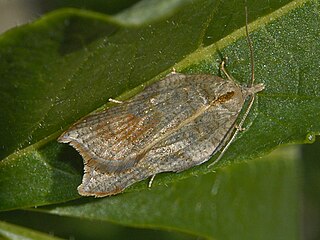
Acleris emargana, the notched-winged tortricid, is a moth of the family Tortricidae. The species was first described by Johan Christian Fabricius in 1775.

Cochylidia rupicola, the chalk-cliff tortrix or conch, is a moth of the family Tortricidae.

Celypha rivulana is a small moth species of the family Tortricidae. It is found in most of Europe.

Cochylis hybridella is a moth species of the family Tortricidae. It is found in most of Europe, the Near East, China, Japan, Korea and Russia.
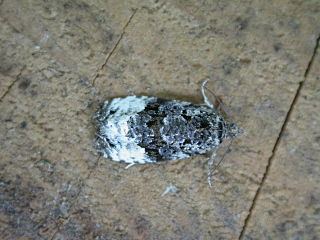
Apotomis sororculana is a moth of the family Tortricidae. It is found in most of Europe, and in the eastern part of the Palearctic realm.

Cochylichroa atricapitana, the black-headed conch, is a moth of the family Tortricidae. It is found in China (Xinjiang) and the eastern Palearctic and most of Europe.

Cnephasia longana, the omnivorous leaftier moth, long-winged shade or strawberry fruitworm, is a moth of the family Tortricidae. It was described by Adrian Hardy Haworth in 1811. It is native to western Europe. It is an introduced species in western North America. The species has also been reported from north-western Africa and Asia. The habitat consists of downland and rough ground.

Cochylimorpha straminea, the straw conch, is a species of moth of the family Tortricidae. It is found in most of Europe, Morocco, Algeria, Tunisia, Asia Minor, the Palestinian territories, Iraq, Syria, Armenia, Transcaspia, Turkmenistan and Iran.
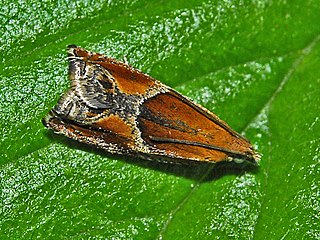
Ancylis obtusana, the small buckthorn roller, is a moth of the family Tortricidae.

Ancylis unguicella is a moth belonging to the family Tortricidae. The species was first described by Carl Linnaeus in his landmark 1758 10th edition of Systema Naturae.






















